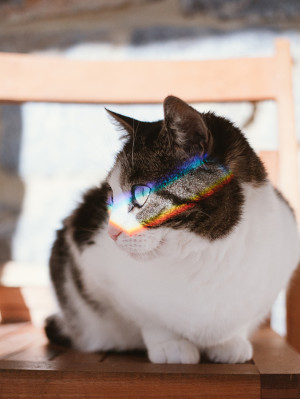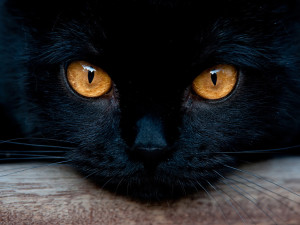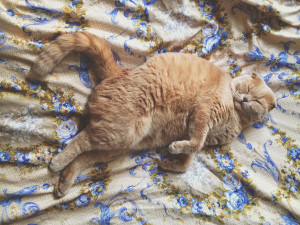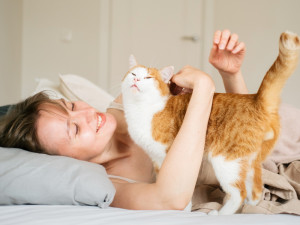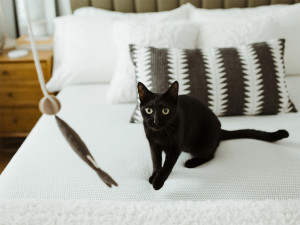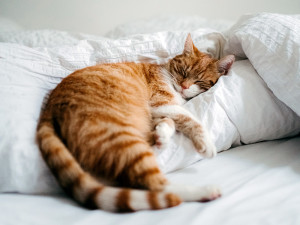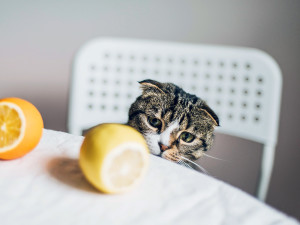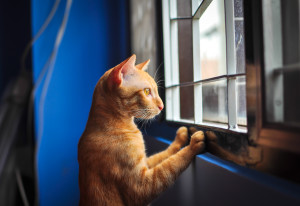How Cats Hunt
Cats have evolved to be skilled hunters, but how and why do they still do it?

share article
Your beloved cat might be living a spoilt life now – turning their nose up at gourmet cat food that you’ve forked out a fortune for and routinely spending their days lazing around the house without a care in the world – but when cats were originally domesticated (around 12,000 years ago), they were primarily kept as pest controllers. Much like their wild ancestors, domestic cats are a predatory species known as obligate carnivores, meaning their diet requires nutrients found only in animal flesh – an ideal workforce for controlling mice and rat populations.
This means our seemingly lazy feline companions are actually descendents of the most adept hunters (Darwin would be proud), and they have lots of specialised skills and adaptations for the job: sharp teeth and claws, lightning-fast reflexes, excellent nighttime vision, superior hearing, speed and power. Despite the fact most domesticated cats now receive everything they need to survive on a plate – literally – this incredibly strong hunting instinct is still hardwired into their DNA, which is why they go wild for stalking and chasing games with laser pointersopens in a new tab and wand toys.
What do cats hunt?
Unlike lions who hunt in packs, domestic cats hunt alone (as do most other big cats), so their prey needs to be small enough to catch and kill – think rodents and birds. If you’ve ever been the recipient of a ‘present’ from your outdoor cat, you’ll be painfully familiar with this fact. In a world where a cat doesn’t receive food from their pet parents and can’t scavenge, like in the case of strays, they would actually need to make as many as 10 to 20 kills per day in order to survive – something worth reminding them as they whinge about that gourmet cat food.
How do cats hunt?
Using their arsenal of skills and evolutionary attributes, cats have a very sophisticated but entirely instinctual method to hunting and killing their prey. But before they can get to that, they have to locate it first, which is where their super-senses come in.
Hearing
Cats have one of the broadest rangesopens in a new tab of hearing among mammals, they can hear similar low-end sounds to us but can hear much higher-pitched sounds, up to 85 kHzopens in a new tab (humans can hear up to 20 kHz). A cat’s outer ear flaps (pinnaopens in a new tab) are shaped to capture sound waves and funnel them through the ear canal to the eardrum, they can also independently point backwards as well as forwards and sideways to pinpoint the source of a sound. Cats can judge the location of their prey within 8cm, and can hear soundsopens in a new tab as far as 883m away.
Vision
Special adaptations of cats’ eyesopens in a new tab allow them to monitor their territory in very low light, needing only about one-sixth of the lightopens in a new tab that humans require to see. Cats also have a much higher proportion of rods in their eyes than humans, which helps them see at lower light levels. As with most predators, their eyes face forwards, giving them great depth perception. However, they are actually quite near-sighted, which means they need to rely on their other senses to initially locate their prey, and then when they get closer they can use their superior ability to see objects close-up to ensure they hit their target upon pouncing.
Smell
A cat’s sense of smell is 9–16 times strongeropens in a new tab than humans. Cats have an estimated 45–200 millionopens in a new tab odour-sensitive cells (olfactory receptor neurons) in their noses, whereas humans only have 10 million; they also have a scent organ in the roof of their mouths that helps them detect prey.
Whiskers
Cats’ whiskers help in hunting, too. They have about 24 of them, which help them sense vibrations in the airopens in a new tab, making them incredibly useful when measuring distances or chasing prey. They can provide detailed information about the shape and activity of the prey when it’s close to their mouth – and when a cat is unable to see its prey because it is too close, their whiskers move to form a basket shape around their muzzle to precisely detect the prey’s location.
After the cat has succeeded in locating and pinpointing their prey, they crouch low to the ground with their head outstretched (similar to the way athletes start a 100m sprint). They move gradually at first, inching closer to their prey until they reach a distance from which they can perform a sprint or ‘spring’. With powerful hind leg muscles, cats can spring forwards with amazing speed and precision – testament to their evolutionary adaptations for both agility and stealth. Once they’ve pounced, the prey is usually killed with a sharp bite to the throat, hence those dagger-like canines you might have been unlucky enough to feel penetrate your hand.
Why do some cats play with their prey?
Cat parents sometimes see their cat playing or ‘toying’ with their prey. There are a number of theories about why this might be. Battersea Dogs & Cats Home suggestsopens in a new tab it may be due to your cat trying to confuse the prey and tire them out, thus making it much easier to kill and reducing their chances of getting injured. Another theoryopens in a new tab points to the idea that it allows cats to hone their hunting skills, practice coordination and maintain physical fitness. It could also serve as a form of stress relief for indoor/outdoor cats who may not have as much opportunity to express their natural instincts in a traditional hunting environment.
If my cat is hunting, does this mean they’re hungry?
Don’t worry, hunting is not a sign that your cat doesn’t like the food you provide or isn’t eatingopens in a new tab enough. Battersea explainsopens in a new tab that it’s just down to the individual cat’s personality and experiences. “A bold, confident cat with lots of experience of going outdoors may need more than their basic ‘resources’ to feel satisfied and are therefore more likely to hunt for stimulation. Alternatively, a shy, quiet cat who is not a big fan of the outdoors may be happier being at home where all their essentials are nearby.”
Should I discourage my cat from hunting?
In other parts of the world, the argument is often made that cats should not be allowed to roam as their hunting activities could cause harm to endangered wildlife, particularly birds, and there are even fines in some cities for letting your cat out: Walldorf in Germany, for instance, previously had a fine in placeopens in a new tab of up to €500 for cat parents letting their cat outside, due to the risk of death to the endangered ground-nesting crested lark – they could even risk being fined up to €50,000 if their cat injured or killed one! And in the US, 70% of cat ownersopens in a new tab now keep their cats indoors, due in part to the fact they kill billions of mammals and birds each year (but reasons also extend to the widespread risk of predators and cars).
In the UK, however, the figure is flipped, with 70% of domestic catsopens in a new tab living an indoor/outdoor life, as access to the outdoors is considered good for cats’ well-being, a position shared by charities such as Cats Protectionopens in a new tab and Batterseaopens in a new tab. The arguments on both sides are complex, and the number of birds and mammals killed by domestic cats are hard to quantify – not to mention the variables of where your cat might live (in rural areas they are more likely to roam further and kill rarer bird species, but in cities their prey is likely to be more ubiquitous, such as robins and blue tits, and they will roam less due to the density of neighbouring cats reducing their territories), how often they go out, how much they kill and what they kill… see, we said it was complex.
Phillip Baker, a mammalogist at the University of Reading, explained toopens in a new tab that Britain and Europe have had native wildcats for millennia, and therefore prey species would have evolved alongside them. And in the UK, he says: “I just categorically say there is no evidence of an impact.” Meanwhile, a spokesperson for the Royal Society for the Protection of Birds (RSPB) said in the same article that they are not particularly concerned about the impact of cats on the British mainland either. “While we know that cats do kill large numbers of birds in UK gardens, there’s no evidence this is affecting decline in the same way that these other issues are.” So the bottom line is, it’s not a huge issue if your cat brings home the odd dead bird – other than the fact they’ve brought a dead bird into your house, obviously.
How can I reduce my cat’s hunting behaviour?
If cleaning up carcasses isn’t your bag, or you are worried about the impact of your cat’s hunting behaviours on wildlife, there are a few things you can try to reduce or stop this behaviour, but we can’t promise they’ll work.
Although your cat’s hunting is not usually because they’re hungryopens in a new tab, ensuring you’re providing food with a high meat content could help stave off their desires to hunt and kill.
Speaking of food, provide this in many small portions throughout the day to mimic the eating patterns they’d have in the wild – try puzzle feedersopens in a new tab or timed feeders if you’re out during the day.
Find an outlet for your cat’s natural instincts and get out their pent up energy by increasing hunting-style play at home using wand toys, kicker toysopens in a new tab or laser pointersopens in a new tab.
Consider keeping your cat indoors during their prime hunting hours when prey are more active, eg dusk and dawn.
All in all, cats’ ability to hunt is not only impressive but also innate, and there isn’t much you can or should do to change that. But of course, each cat is unique, so whether you have a hunter or a chiller on your hands, it’s all part of the beauty of being a cat parent.

Ro Elfberg
Ro is The Wildest’s Senior Editor. She has previously written and copy-edited for British Vogue, Glamour and DICE. When she’s not being manipulated into dishing out Dreamies to Kobe the cat, she spends her free time trying to convince her snake, Butters, to wear a tiny hat.
Related articles
![orange cat sleeping on pillow]() opens in a new tab
opens in a new tabCan Cats Have Nightmares?
If so, they’re probably about going to the vet in that stupid carrier
![a black cat’s amber eyes]() opens in a new tab
opens in a new tabWhy Do Cats’ Eyes Glow in the Dark?
Those glowing orbs are actually a pretty useful result of evolution
![Happy woman and cute cat playing with disco ball glitter confetti at home.]() opens in a new tab
opens in a new tab11 Ways to Raise Your Cat Parenting Game in 2024
Make this new year a great one for your kitty
![Home cat sitting on a chair with citrus.]() opens in a new tab
opens in a new tabEverything You Need to Know About Your Cat’s Incredibly Powerful Nose
They have up to 200 million odour receptors that can pick up all the good (and horrible) smells. Learn how to best support their sensitive sniffers
![Woman laying on her bed while hugging her cat]() opens in a new tab
opens in a new tabWhy Does My Cat Wake Me Up At the Crack of Dawn?
Here’s what to do when your cat starts pawing at your face before the sun has even come up
![orange cat looking out window]() opens in a new tab
opens in a new tabIs Your Cat’s Separation Anxiety Ruining Their Life and Yours?
Why your cat freaks out when you’re away (and how to help)

